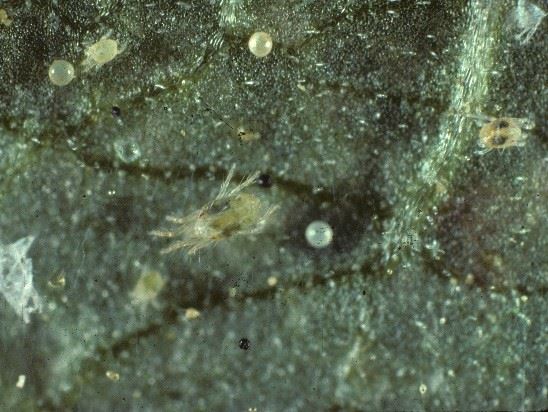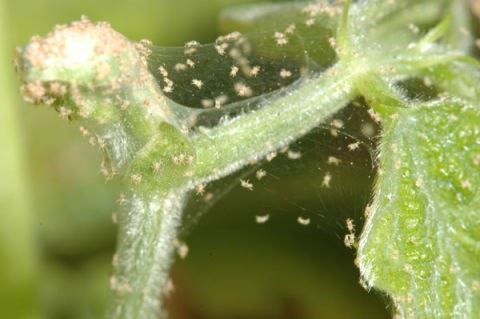Spider mites, (Family Tetranychidae, Order Acari), are not insects; they are from insect hell and are very small arachnids closely related to spiders and ticks. Among plant pests, mites are among the most difficult to control, and are responsible for a significant portion of all pesticides used on ornamentals. Individual spider mites are almost microscopic, yet when they occur in large numbers, they can cause serious plant damage. Once present, spider mites are seldom eradicated, and are almost undetectable even by the best of scouts.
Spider mites that commonly cause damage on ornamental plants include the two-spotted spider mite, Tetranychus urticae Koch. There are other speices, but I want to pick on this little beast.
The life cycle of the two-spotted spider mite is typical of warm weather spider mites, including the tumid spider mite. At 85–90 degrees F, complete development from egg to adult can occur in as little as seven to eight days. That is a lot of young’uns. All life stages may be present throughout the year, depending on the weather. When temperatures are cooler, development may proceed more slowly, requiring up to four weeks for completion. Still, that is still a lot of young’uns. Host plant species, plant nutrition, leaf age, and moisture stress also influence development. Many generations occur each year, depending on the species of spider mite. For those of us who have temperature-controlled greenhouses or conservatories, the spider mite can be a year-round problem. On a scale of 1 to 10, I find managing these little monsters about a 9.9. The problem is scouting. Young eyes, old eyes, it doesn’t matter.
Adult female two-spotted spider mites are about 0.5 mm long, light green with two brownish black spots on either side of the abdomen. Color will vary according to diet and environmental conditions. Males have pointed abdomens and are more slender than the rounded and plump females. Now, personally, I have never been able to tell the girls from the boys, they are equally hateful. Females lay between 90 and 110 eggs during their lifetime. Eggs hatch into six-legged larvae, which then develop into protonymphs, followed by the deutonymph stage prior to adulthood. Yada, yada, yada. Now, personally, I can locate mites or damage easily with or without a hand lens. Yet, I can show the exact same leaf to someone else and I get the look like… “What?!”

Know your bugs fool. It may be the difference in this:

To this:

I mean really guys; how do you not see this?
Under hot, dry conditions, two-spotted spider mites thrive: more eggs are laid, development is at a higher rate, and survival of adults is extended. Conditions of high moisture are known to slow the dispersal of mites.
So, what to do about this pesky critter? The problem is, there is never just one. One day you see nothing and the next day your plant is covered in webbing and you stand there wondering what the heck just happened and contemplating a new job. Been there, done that. I know bugs, but how did you sneak in?
Growth is slowed with higher humidity, so syringing is a great option. I love to blast those devils, and, in my case, I find it fairly successful. I use little to no chemicals, so scouting is a must. Hand picking leaves, syringing, applying beneficials (I like Phytoseiulus persimilis), culling, praying, cussing are all valuable tools in controlling these creatures.
And believe me, if you can survive a greenhouse covered in webbing and mites and live to tell the tale, you can handle anything! Well, maybe not thrips.
Until next time...
By Denise Rogers, Curator of Horticutlure, North Carolina Zoo